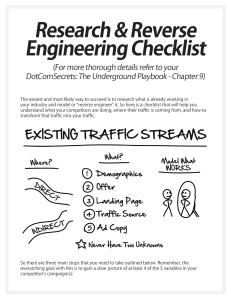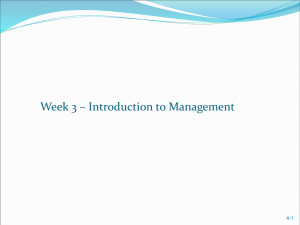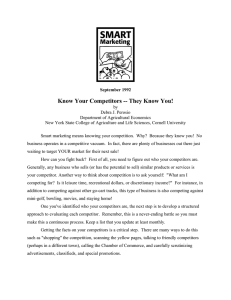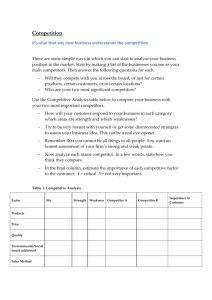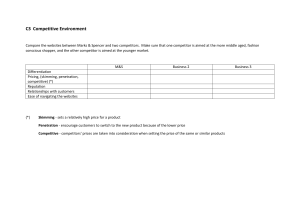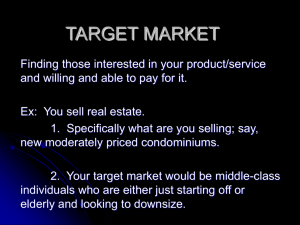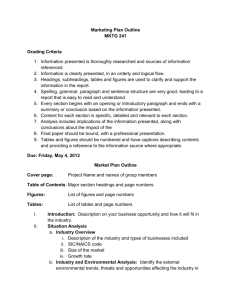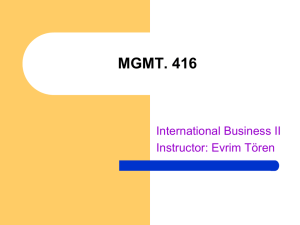NEW VENTURE MANAGEMENT
advertisement
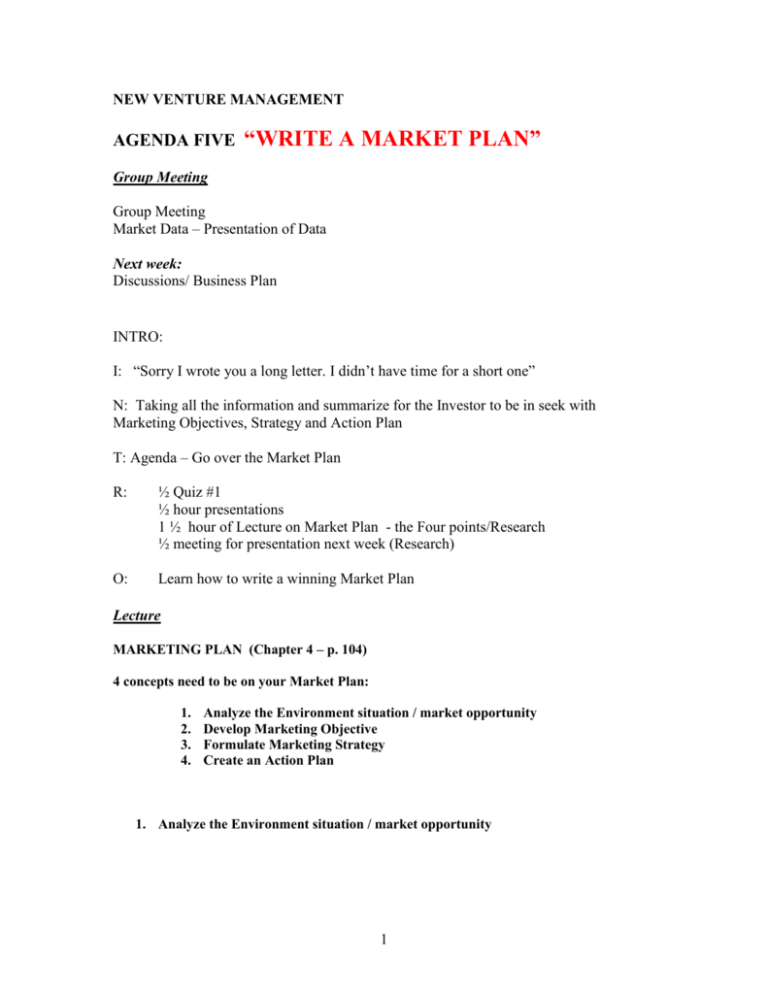
NEW VENTURE MANAGEMENT AGENDA FIVE “WRITE A MARKET PLAN” Group Meeting Group Meeting Market Data – Presentation of Data Next week: Discussions/ Business Plan INTRO: I: “Sorry I wrote you a long letter. I didn’t have time for a short one” N: Taking all the information and summarize for the Investor to be in seek with Marketing Objectives, Strategy and Action Plan T: Agenda – Go over the Market Plan R: ½ Quiz #1 ½ hour presentations 1 ½ hour of Lecture on Market Plan - the Four points/Research ½ meeting for presentation next week (Research) O: Learn how to write a winning Market Plan Lecture MARKETING PLAN (Chapter 4 – p. 104) 4 concepts need to be on your Market Plan: 1. 2. 3. 4. Analyze the Environment situation / market opportunity Develop Marketing Objective Formulate Marketing Strategy Create an Action Plan 1. Analyze the Environment situation / market opportunity 1 A. Are your products/services or product/service lines? Description: Despite unique features and attributes for each Product and Services What is the target market? Product life-cycle Demonstrate evidence of need and problems solved Why hasn’t need been filled? Need Benefits What are the benefits to users How is it better than alternatives or substitutes Pricing Model What is the price (pricing table if necessary) How much will it cost? How does it compare with competitors’ P/S Current Stage Development Where the P/S stands now What else needs to be done and how much $ R&D activities (present and future) Future Plans and Development Follow-on products or upsells New markets or expansion opportunities? Intellectual Property What IP does the product/service have Who owns the IP? 2 Are there any potential limitations/litigation Other Images, diagrams or screenshots Etc. B. What is the dollar size of your markets? Note: use the Chain Ratio Method –estimate Market size Demographics Geographics’ Psychographics’ Geo/Demo/Phycho-graphics Total Population Total Adult North East Gender- Female Income - $75,000 Plus Physically Active Percent of Polulation 100% 67/5% 25.0% 51.0% 19.6% 40.0% Target Market Size 289,354,000 195,192,000 48,798,000 24,887,000 4,878,000 1,951,200 Other Data: % that purchase expensive shoes (over $100): 40% Average number of purchases per year: $5 Average Purhase price: $150 $1,951,200 * .40 * 5 * 150 = $585.4 Million Market Mapquest Method to estimate market size MAP WITH CIRCLES (5 MILES, 10 MILES) Industry Analysis o (Trends, Growth Patterns, Five Force Analysis) C. What is your sales and distribution setup? Target Market D. What geographic area do you sell to? 3 Target market E. Describe your audience in terms of population, demographics, income levels and so on. Market Analysis o (Market Overview – trends, growth, target market (size) o Buying Behavior F. What competitors exist in this marketplace? Competitive Analysis Overview – Current Competitive landscape How competitive is the industry? How will company capture the competition’s share of the market? Identify the service, quality and cost leaders in the area Direct & Indirect Competitors Identify most important direct and indirect competitors Strengthe and weaknesses of each What is the market share of the market? What are the product/services features What are the revenues, number of employees, location, ADR, OR Provide a Chart Competitor Reaction What is the importance of the target market to the competitor? What are their likely responses? How quick of a response How will you mitigate comp. Reactions G. Historically, how well have your products sold? Current situation – Opportunities 2. Develop Marketing Objective 4 State for each target market in terms of sales, profit contribution and other qualitative aims, such as building an image o Market Performance Objectives (sales and profits) o Marketing Support Objectives (tasks that precede final performance outcomes such as building customer awareness and engaging in educational efforts. Objectives Must be measurable Worden Carefully – to achieve that Image in the minds of Investors 3. Formulate Marketing Strategy Marketing Strategy Overview How will you create awareness within customers? Identify specific marketing philosophies and strategies Market penetration strategy Positioning Identify the unique selling proposition (does it satisfy a need?) Describe the company’s image and positioning statement What are the costs? Media and production % target market reach and frequencies PR and Promotions Describe overall strategy, goals and objectives What are the material and other costs? Outsource or in-house 4. Create an Action Plan Sales Strategy Overview Identify specific sales philosophies and strategies How will you acquire customers? What are the distribution channels? Are relationships established? Whom? Sales Force How many people involved in sales? In-house or outsource? How much? Special training or expertise needed? Sales Process Description How will the customer pay? How will customer receive services What is the typical cycle/season After sales support? Describe discounts, guarantees, warrantees, etc. Sales Projections Describe major assumptions 5 What is sales growth rate and how it is determined 6
